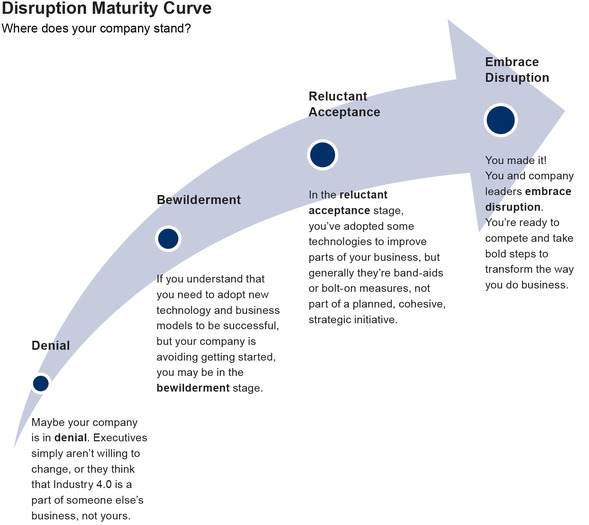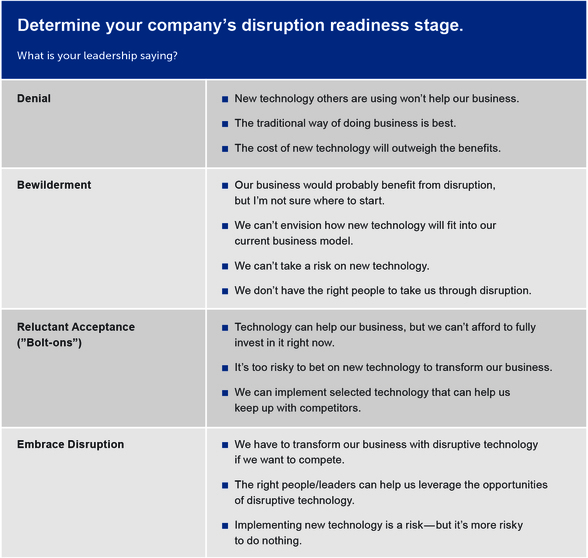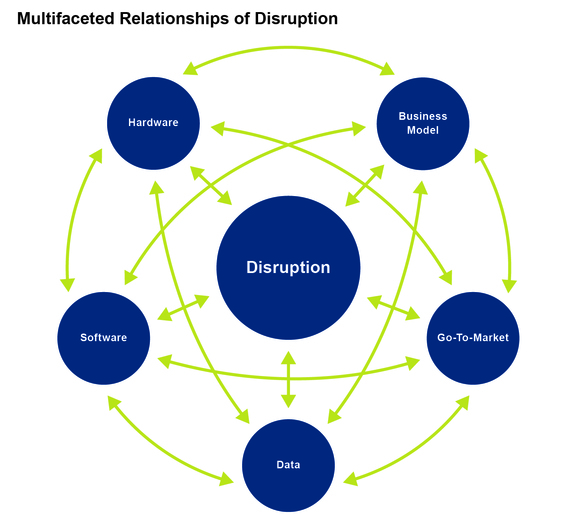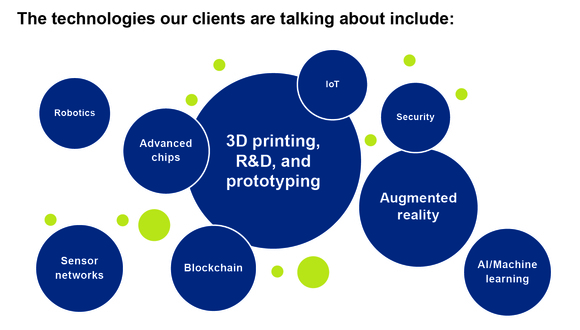Determining your company’s readiness for disruption can help you break down barriers to adopting new technologies that are essential for Industry 4.0.
The future of the industrial sector has arrived. It’s a custom-designed microbe that can enhance a sustainable agriculture venture or even prevent the effects of biological weapons. It’s radio-sized satellites launched into space to track international shipping.
It’s also a trillion dollar opportunity where the vast majority of industrial companies are losing out, according to consulting firm McKinsey. In general, most companies aren’t embracing Industry 4.0 in full force, and, even if they do implement technology, they’re picking and choosing selected applications.
Total disruption is never easy. But technology is revolutionizing the industrial sector to be faster, smarter, more flexible and more efficient. High-quality products will be developed and produced at lower cost. The nature of how we do business will change, as will the makeup of the industrial workforce itself, as more employees will be required to have technical expertise.
What it Takes to Embrace the Change
No company wants to get blindsided by a disruptor like Uber or Amazon, but obviously you can’t snap your fingers and suddenly find your company transformed into an Industry 4.0 competitor. Most likely, your company has started the transformation process by adopting technologies like cloud computing, AI and virtual reality. Often these piecemeal solutions fill an immediate need, but they’re rarely part of a holistic strategy.
It comes down to this:
Fully embracing Industry 4.0 starts with knowing where you are in the disruption process and what kind of leadership you need to fully transform.
Self-Analysis: Where is Your Company on the Disruption Readiness Curve?
The upsides of transformation are almost limitless: efficiencies,competitiveness, revenues. However, the barriers are plentiful as well. To begin identifying solutions to those barriers, it helps to analyze your organization’s readiness to pursue transformation.

If you’re not ready to fully embrace disruption, it’s likely your company resides somewhere further down along disruption maturity curve. The more accurately you determine your starting point, the easier it will be to move towards a transformative solution.
To take a deeper dive into where your company resides on the curve, see which phrases below reflect your company’s leadership.

Next Step: Identify Types of Disruption
Identifying your readiness level to embrace disruption will help your company (and industry) contend with competitors, but you also need to evaluate the aspects of your business are most vulnerable.
The most common scenario of industry disruption is one where a small start-up, often from a different industry, successfully challenges an established industry leader. This cycle now happens exponentially faster.
In the past, up-and-comers usually had to invent their own technology, which could take years. Today, disruptors often take existing technologies and apply them in unique, multidimensional ways. For example, building IoT and sensor networks can automate tasks, disrupting established business processes. Technology like machine learning and data analytics can transform go-to-market strategies with customized selling and pricing models.
As you take on the task of unlocking technology’s potential, it helps to know the types of disruption pressuring your company and industry. We use a framework like the one below to start a conversation with clients about the technologies they use, the ones their competitors and new entrants have implemented, and what aspects of their businesses are most impacted.

Examples: How Disruption Effects Businesses

These advances affect everything from supply chain management to pricing models. Some examples:
- Products are getting smarter. Many communicate via IoT or have smart features, like on-demand performance. This includes cars with IoT, wearable technology, and products that perform their own predictive maintenance.
- Business models are transforming. Data analytics, optimization and data exchanges are some of the ways that software and business models intersect. One example is the growth and popularity of Airbnb. Airbnb uses network effect to compete with hotels by using rooms with a novel source of supply unencumbered by the fixed cost structure of the incumbents.
- Customer demands are increasing. Along with traditional demands like cost, quality and delivery, customers are now also focused on things such as real-time data, sustainability and traceability. Blockchain can help meet these demands. For example, the nascent cannabis industry is learning to capitalize on this emerging technology by building blockchain technology into its supply chain and infrastructure to ensure traceability, quality, and reduce costs.
- R&D cycles are shrinking. 3D printed prototypes greatly accelerate the R&D process, cutting the time and cost of new product launches. A company called Spire is using existing technology to build and deploy mini-satellites at a much lower cost than government satellites, opening the door for more frequent commercial use of satellite technology.
- The options for go-to-market strategies are multiplying with applications like AI and machine learning. Data analysis tools can help optimize pricing to maximize value with specific customers or segments. Sales and performance data can be monitored in closed-loop systems, improving outcomes with each transaction.
How Executive Hiring Fits In
When DHR meets with companies to discuss their hiring needs, we start with a discovery process to determine the kinds of technical or functional talent that will deliver the most value.
Together, we build a hiring profile that meets your company’s needs as they are now – not just how they could be in the future. The leaders you hire need to have strong knowledge of the disruptive technologies placing the most pressure on your company and industry and the ability to guide the organization up the maturity curve. Even more challenging, they need to lead you through the disruption process while keeping your existing lines of business profitable.
We work with companies everyday that are in various stages of transformation. Understanding your company’s starting point on the disruption maturity curve will help you hire the right person:
- If you’re on the low end of the disruption curve, your candidate will need to be a great communicator with a startup mentality and possess a strong strategic vision and the tenacity to push through new ideas.
- If you’re further along the curve and are ready for disruption, you may be looking for specific people to execute your strategy, such as experienced IT leaders, IoT experts, or data scientists.
Technology is a priority for industrial firms to innovate, gain market share and increase revenue. For the vast majority of companies, it’s going to take a complete disruption of business-as-usual to stay competitive. With our unique search methodology, deep resources, and proven knowledge in the industrial sector, our consultants leverage their global networks to grow your dynamic team of innovative technology leaders.
Let’s talk about your business today, goals for tomorrow and the leadership you need for the transformation.
